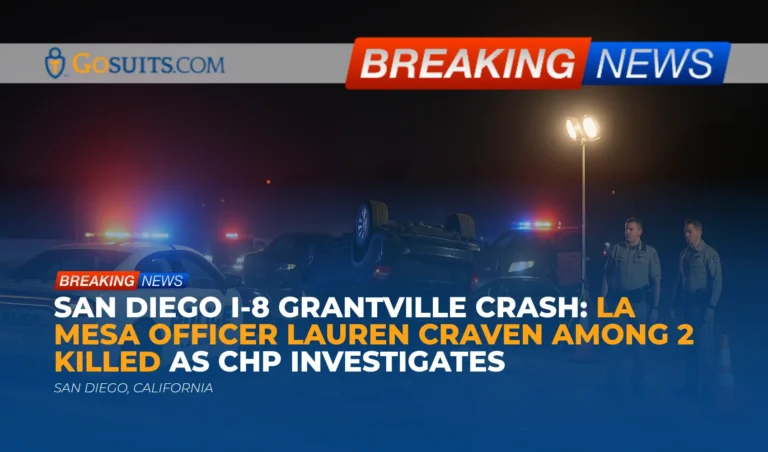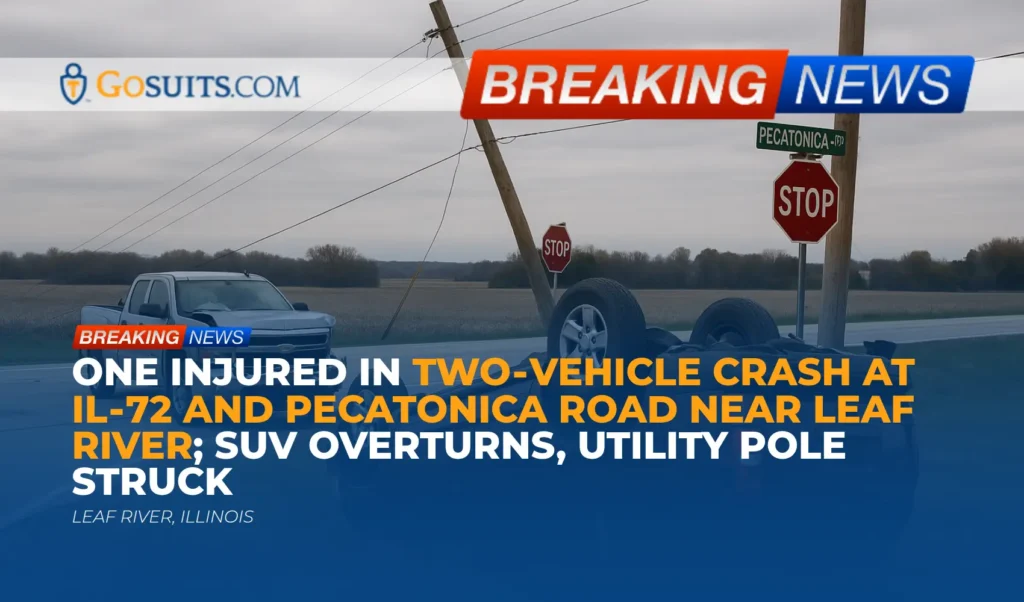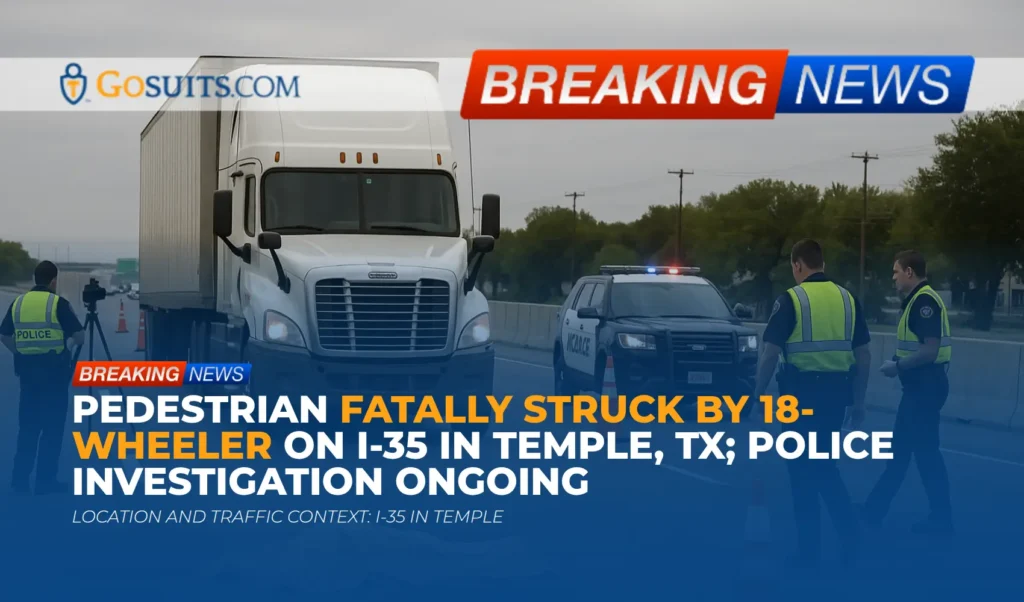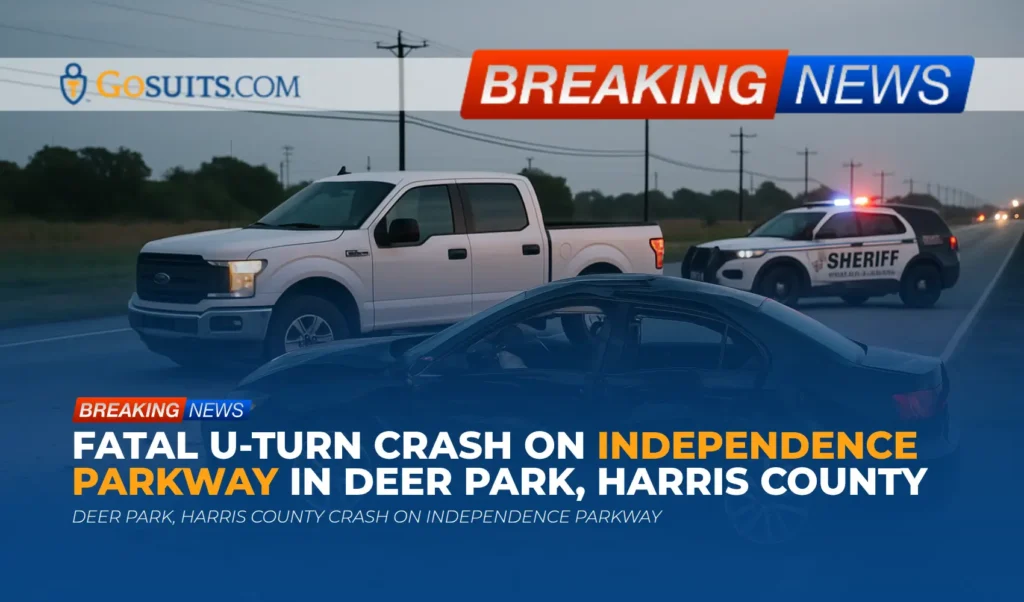- What We Know About the I-8 Multi-Car Crash in Grantville
- Road Closures and Official Response
- Laws That Protect Roadside Responders in California
- Why Secondary Crashes Happen on Freeways at Night
- Potential Civil Liability and Insurance Considerations
- Practical Steps After a Serious Freeway Crash
- Where and How to Request Official Records
- Support Resources for Families of Fallen Public Safety Officers
- Preserving Your Rights: Key Deadlines in California
- Commentary from Gosuits San Diego, California Personal Injury Attorney
- Why Acting Promptly Matters After a Catastrophic Crash
- Sources
What We Know About the I-8 Multi-Car Crash in Grantville
Late Monday night, just before 10:30 p.m., a multi-vehicle collision occurred on eastbound Interstate 8 near Fairmount Avenue in Grantville, a neighborhood in the City of San Diego. According to statements relayed by the California Highway Patrol (CHP) at the scene, an eastbound vehicle struck another car and overturned in the traffic lanes. Subsequent vehicles then collided with the overturned vehicle. A La Mesa Police Department officer, on duty and witnessing the initial crash, stopped and exited her patrol car to render aid. While she was assisting, an approaching vehicle struck the officer and the other involved vehicles. A second vehicle then collided with the wreckage. In total, five vehicles were implicated in the chain-reaction event.
CHP confirmed two fatalities: the La Mesa police officer who stopped to help, and the driver involved in the initial crash. Other injured individuals were transported to area hospitals for treatment. The La Mesa Police Department publicly identified the fallen officer as 25-year-old Officer Lauren Craven, who joined the department in February 2024. Local officials have asked the community to keep Officer Craven’s family and colleagues in their thoughts during this difficult time.
As of the latest updates, the cause of the initial crash remains unknown and is under investigation by the CHP. In the hours following the incident, eastbound I-8 was fully closed in the area while investigators documented the scene and crews cleared debris.
Road Closures and Official Response
Caltrans issued a SigAlert and implemented a full closure of eastbound I-8 between I-15 and Waring Road. Traffic was diverted to southbound I-15, and traffic from both northbound and southbound I-15 to eastbound I-8 was diverted off at Fairmount Avenue and Montezuma Road. CHP indicated they anticipated reopening by midday, but closures of this scale can last several hours depending on the complexity of the investigation, debris removal, and any necessary repairs to roadway infrastructure.
SigAlerts and freeway closures are used to keep the scene safe for investigative teams and roadway crews and to prevent additional secondary crashes. Caltrans and CHP typically coordinate detours to reduce congestion near the investigation zone. For future real-time updates during major events, Caltrans QuickMap provides current closures, incidents, and traffic speeds across California.
Helpful resource: Caltrans QuickMap is available at quickmap.dot.ca.gov.
Laws That Protect Roadside Responders in California
California’s Move Over law is designed to reduce the dangers faced by emergency responders, road workers, tow operators, and stranded motorists on the shoulder or in the lanes after a crash. The law requires drivers approaching a stationary authorized emergency vehicle displaying emergency lights to move over a lane if it is safe to do so, or, if that is not possible, to slow down to a reasonable and prudent speed for the conditions. This requirement also applies to tow trucks and Caltrans vehicles displaying warning lights. Failing to comply increases the risk of secondary collisions and responder “struck-by” incidents.
Key points under California law:
- Move Over and Slow Down: Drivers must move over one lane for stationary emergency vehicles with flashing lights when safe and feasible; if not feasible, they must slow to a safe speed for conditions. See California Vehicle Code section 21809.
- Obey Traffic Control and Incident Scenes: Drivers must heed cones, flares, arrow boards, and traffic control devices set by responders, consistent with federal roadway safety standards and state law.
Why this matters: Nighttime freeway scenes are inherently hazardous. Even with emergency lights, flares, and reflective PPE, responders are vulnerable. Federal highway safety programs underscore that traffic incident management and driver compliance with move-over requirements are critical to reducing secondary crashes and struck-by injuries.
Why Secondary Crashes Happen on Freeways at Night
Secondary crashes are collisions that occur as a direct or indirect result of a primary incident. They often happen near the scene of an initial crash and may involve approaching drivers who fail to perceive stopped traffic, debris, or responders in time to avoid impact. Several risk factors commonly converge in nighttime freeway incidents:
- Reduced Visibility: Darkness, glare from headlights and emergency beacons, and complex lighting patterns can compromise depth perception and reaction time.
- High Approach Speeds: Freeway speeds reduce the margin for error; even a brief lapse can result in a high-energy crash.
- Lane Blockages and Unusual Geometry: An overturned vehicle or debris within travel lanes creates sudden hazards, with traffic rapidly queuing and unexpected stops.
- Driver Inattention or Impairment: Fatigue and distraction are more prevalent at night; impairment further elevates risk.
- Limited Escape Options: Concrete barriers, narrow shoulders, and ongoing closures restrict evasive maneuvers, increasing chain-reaction potential.
National safety authorities urge drivers to actively scan for emergency lights, slow well in advance, and transition lanes early where possible. Roadside responders use incident command, advance warning signs, and traffic control devices to create safer work areas, but those measures rely on approaching drivers to cooperate quickly and consistently.
Potential Civil Liability and Insurance Considerations
Chain-reaction crashes can be complex. California applies comparative fault principles, meaning responsibility may be allocated among multiple drivers and entities based on their respective contributions to the harm. Actual fault apportionment depends on a fact-specific investigation, including vehicle positions, speed, lighting, driver behavior, and whether move-over and slow-down duties were met.
Possible avenues of civil responsibility
- Drivers who failed to slow or move over: If evidence shows a driver approached an active incident and failed to move over or reduce speed, that breach can be a basis for negligence.
- The initial crash driver: If the first collision resulted from negligent conduct, that may be a contributing factor to subsequent harms. Investigators will examine vehicle condition, speed, and roadway dynamics.
- Third-party liability: In rare circumstances, other factors may play a role, such as cargo spills, defective equipment, or unsafe roadway conditions. Evidence must support any such theory, and these evaluations should be grounded in facts rather than assumptions.
Insurance dynamics in multi-vehicle events
- Multiple competing claims: With several injured parties and two fatalities, claimants may be pursuing recovery against the same liability policy or policies. This can trigger difficult questions about per-person and per-occurrence limits.
- Underinsured and uninsured motorist coverage: Injured occupants may turn to their own UM/UIM policies if at-fault drivers lack adequate coverage.
- Workers’ compensation and line-of-duty benefits: For a public safety officer killed or injured while working, workers’ compensation death benefits and certain federal benefits may be implicated alongside any civil claims against third-party drivers.
- Comparative fault assessments: Insurers may assert partial fault on multiple parties to reduce payouts. Clear evidence, prompt preservation of records, and careful statements can be critical to protect rights.
Before speaking with any insurer about fault or injuries, it is prudent to consult with a seasoned and skilled injury attorney. Statements to an insurer can be used to minimize or contest claims later. A free consultation can help clarify options, timelines, and steps to protect evidence.
Practical Steps After a Serious Freeway Crash
Serious collisions create shock and confusion. The sequence below can help organize priorities in the hours and days that follow. Adapt these steps to the circumstances and safety instructions from authorities.
- Prioritize safety and medical care: Follow responder directions, obtain medical evaluation promptly, and document symptoms. Many injuries are not immediately obvious at the scene.
- Preserve evidence early: Save photos, dashcam footage, and contact details for witnesses. Preserve damaged clothing and personal items. If a vehicle is towed, note the yard location and hold on to all tow paperwork.
- Keep all records in one place: Hospital discharge instructions, imaging reports, pharmacy receipts, and time-off documentation can become important later.
- Avoid discussing fault: Do not speculate about causes in public or on social media. Decline recorded statements to insurers until you have received legal guidance.
- Consult before calling insurers: Contact an attorney first. Insurance adjusters work to limit payout exposure and may use your statements against you later.
- Request official reports when ready: See the section below for how to obtain the CHP collision report and, where applicable, medical examiner records.
Where and How to Request Official Records
Obtaining accurate records helps families and injured individuals understand what happened and make informed decisions. The following government sources can provide key documentation.

Traffic collision report (CHP)
The CHP typically investigates freeway collisions in San Diego County. To request the crash report, use the CHP 190 form (Application for Release of Information). You will need details such as the date, time, location, and party names to help identify the report. Eligible requesters include involved parties and their representatives.
- CHP collision report request: CHP-190
- Public records from CHP (e.g., CAD logs): CHP Public Records
Tip: If you have a CHP incident number, include it. If not, provide the precise time window, direction of travel, milepost if available, and nearby interchanges.
Medical Examiner records (San Diego County)
In fatalities, the San Diego County Medical Examiner handles examinations and issues the death certificate. Next of kin can request autopsy and toxicology reports when available. Processing times vary; toxicology can take several weeks.
- San Diego County Medical Examiner: County Medical Examiner
Have identifying information ready, such as the decedent’s name, date of death, and case number if known. The office can explain eligibility, fees, and estimated timelines for release.
Roadway and incident information (Caltrans)
Caltrans maintains traffic management systems and can provide public roadway status and incident information, though investigative reports belong to law enforcement. QuickMap displays closures and traffic speeds in near real time. While not an official investigation record, screenshots and timestamps can help corroborate closure periods or congestion patterns.
- Caltrans QuickMap (closures and traffic): quickmap.dot.ca.gov
Hospitals and EMS
Injured patients can obtain medical records directly from treating hospitals and EMS agencies. Request emergency department records, imaging, physician notes, and EMS run reports. Hospitals will confirm identity and may require signed authorizations.
Support Resources for Families of Fallen Public Safety Officers
When a public safety officer is killed in the line of duty, families may be eligible for certain benefits in addition to any civil claims against at-fault parties. These programs have specific eligibility criteria and documentation requirements.
- Public Safety Officers’ Benefits (PSOB) Program: A federal program that may provide death benefits for eligible line-of-duty deaths. See the U.S. Department of Justice, Bureau of Justice Assistance PSOB Program at bja.ojp.gov.
- California workers’ compensation death benefits: Families of employees who die from a work-related injury may qualify for death benefits. See the California Department of Industrial Relations information at dir.ca.gov.
These resources are separate from civil actions against third-party drivers. Families can explore both pathways. Coordinating benefits and claims can be complex, so many families consult legal counsel to avoid missing critical deadlines or duplicating processes.
Preserving Your Rights: Key Deadlines in California
California law sets strict timelines for bringing civil claims. Missing a deadline can permanently bar recovery, even when liability appears clear.
- Wrongful death statute of limitations: Generally two years from the date of death. See California Code of Civil Procedure section 335.1: leginfo.legislature.ca.gov.
- Who may bring a wrongful death claim: California Code of Civil Procedure section 377.60 identifies eligible family members and dependents: leginfo.legislature.ca.gov.
- Claims involving public entities: If a government entity is a potential defendant, a written claim may be due within six months under the Government Claims Act. See Government Code section 911.2: leginfo.legislature.ca.gov. For state agencies, the California Department of General Services provides claim procedures: dgs.ca.gov.
Because different deadlines can apply depending on the parties involved, it is wise to consult with counsel promptly to map out the correct timeline before contacting any insurance company.
Commentary from Gosuits San Diego, California Personal Injury Attorney
Our hearts are with Officer Lauren Craven’s family, her colleagues at the La Mesa Police Department, and every person affected by this tragedy. This overview is provided for educational purposes and general information to help the community understand the civil implications that follow a catastrophic freeway crash.
From a civil injury perspective, nighttime chain-reaction collisions underscore how quickly a secondary crash can transform an already dangerous scene into a fatal one. California’s Move Over law exists precisely to protect those on the roadway shoulder and in active lanes after a collision. When drivers fail to move over or slow down, the consequences can be devastating. Determining fault in a five-vehicle sequence requires a careful, methodical analysis of approach speeds, lighting, lane positions, braking data, and whether reasonable steps were taken by approaching motorists to reduce speed and provide a lane of safety.
Insurance companies and large corporate risk managers routinely move fast after high-profile collisions. They may request recorded statements, seek quick medical authorizations, or propose early settlements before the full scope of harm is understood. In multi-vehicle events, they may also attempt to distribute fault across multiple parties in ways that reduce their own exposure. Without experienced guidance, families can accidentally concede facts or timelines that are later used to diminish recovery. Before communicating with any insurer, it is prudent to obtain a free consultation so you understand your rights, the potential value of evidence, and the deadlines that govern your case.

Why Acting Promptly Matters After a Catastrophic Crash
Timing affects outcomes in tangible ways. The following actions help ensure that crucial information is secured and rights are preserved:
- Secure evidence while it exists: Skid marks fade, vehicles are repaired or salvaged, and dashcam data is overwritten. Promptly preserving photographs, vehicle data, and witness contacts can make a meaningful difference.
- Obtain official records early: CHP reports, medical examiner files, and hospital records often take weeks. Initiating requests now can align with investigative milestones and prevent delays when decisions must be made.
- Protect statements: What is said to insurers can shape liability decisions. Speaking with an attorney before any recorded statement helps avoid unintended admissions.
- Meet strict deadlines: California imposes tight timelines for wrongful death and personal injury claims, and even shorter claim-presentation rules may apply if a public entity is implicated. Early planning prevents missed windows.
- Coordinate benefits: For public safety families, workers’ compensation, federal PSOB benefits, and third-party claims may overlap. Coordinated timing can help avoid conflicts and maximize available support streams.
Taking these steps promptly provides clarity, reduces the risk of evidence loss, and positions the matter for a thorough evaluation once official findings are released.
Sources
The following government resources provide relevant law, safety guidance, and procedural information:
- California Vehicle Code section 21809 (Move Over): leginfo.legislature.ca.gov
- CHP Move Over information: chp.ca.gov
- CHP collision report request (CHP-190): chp.ca.gov
- CHP public records requests: chp.ca.gov
- Caltrans QuickMap (closures/traffic): quickmap.dot.ca.gov
- California wrongful death statute (CCP §377.60): leginfo.legislature.ca.gov
- California statute of limitations (CCP §335.1): leginfo.legislature.ca.gov
- Government Claims Act deadline (Gov. Code §911.2): leginfo.legislature.ca.gov
- California DGS Government Claims Program: dgs.ca.gov
- San Diego County Medical Examiner: sandiegocounty.gov
- NIOSH/CDC: Motor-Vehicle Safety for Law Enforcement Officers: cdc.gov
- FHWA: Traffic Incident Management (TIM): ops.fhwa.dot.gov
- MUTCD (federal traffic control standards for incident scenes): mutcd.fhwa.dot.gov
- U.S. DOJ PSOB Program (line-of-duty death benefits): bja.ojp.gov
- California DIR: Workers’ Compensation Benefits Overview: dir.ca.gov






